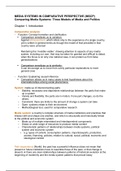MEDIA SYSTEMS IN COMPARATIVE PERSPECTIVE (MSCP)
Comparing Media Systems: Three Models of Media and Politics
Chapter 1. Introduction
Comparative analysis:
- Function: Concept formation and clarification
Comparison sensitizes us to variation:
Against ethnocentrism: which refers only to the experience of a single country,
yet is written in general terms as though the model of that prevailed in that
country were universal
Rendering the ‘invisible visible’: drawing attention to aspects of any media
system, including our own, that may be taken for granted and difficult to detect
when the focus is on only one national case, it can protect us from false
generalizations
Comparison sensitizes us to similarity:
It can encourage us to move from overly particular explanations to more
general ones
- Function: Explaining causal inference
Comparison allows us in many cases to test hypotheses about the
interrelationships among social phenomena
System: made up of interconnecting parts
- Stability: necessary and dependent relationships between the parts that make
up a system
- Variety and flexibility: the parts are in motion; if one part changes, so do the
others
- Constraint: there are limits to the amount of change a system can take
- Open: systems relate to their environment
- Methodological tool, used for comparative research
Media system: a country’s complex structure of media institutions and practices that
interact with and shape one another, and which is structurally and historically linked
to the political and economic system
- Made up of multiple interrelated and interdependent components
- Draws on wide range of resources to produce media content
- Characteristic patterns of relationships between media systems, political
system and economic system
- e.g. types of content, consumption patterns, imports/exports, production,
access, financing, policies, relation to cultural, social, political, economic and
ideological context
Path dependence [North]: the past has a powerful influence (does not mean that
present or future institutions have to resemble those of the past, or that change is
absent) there are clear relationships between patterns of historical evolution at the
beginning of modernity and the media system patterns that prevail today








